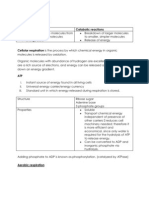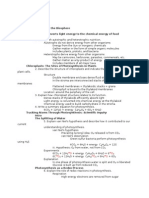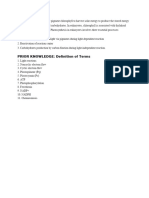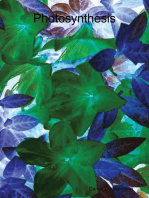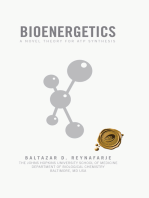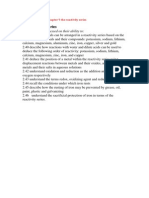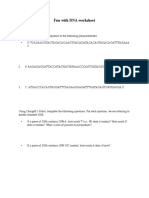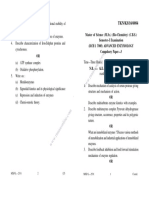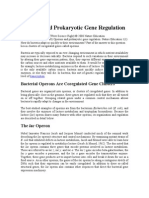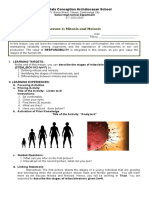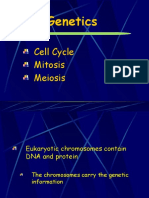Unit 8-Cell Respiration and Photosynthesis
Unit 8-Cell Respiration and Photosynthesis
Uploaded by
Abhilasha ChoudharyCopyright:
Available Formats
Unit 8-Cell Respiration and Photosynthesis
Unit 8-Cell Respiration and Photosynthesis
Uploaded by
Abhilasha ChoudharyOriginal Description:
Copyright
Available Formats
Share this document
Did you find this document useful?
Is this content inappropriate?
Copyright:
Available Formats
Unit 8-Cell Respiration and Photosynthesis
Unit 8-Cell Respiration and Photosynthesis
Uploaded by
Abhilasha ChoudharyCopyright:
Available Formats
Unit 8 8.1.1 State that oxidation is loss of electrons from element and loss of hydrogen/gain of oxygen.
Reduction is gain of electrons from element and gain of hydrogen/loss of oxygen.
8.1.2 Outline the process of glycolysis, including phosphorylation, lysis, oxidation and ATP formation. 1. Glycolysis occurs in cytoplasm where hexose sugar is converted to two pyruvate compounds with net gain of 2 ATP and 2 NADH and H+ 2. Glycolysis begins when hexose is phosphorylated, using the energy from ATP, to form hexose phosphate. 3. Hexose phosphate is then split (lysis) to form two triose molecules. 4. Each triose phosphate molecule is oxidised to form glycerate-3-phosphate. Oxidation occurs, electrons are lost and hydrogen H+ is removed from each of the triose phosphate molecules and accepted by NAD+, forming NADH and H+ 5. Glycerate-3-phosphate is then further phosphorylated, whereby phosphate groups are transferred to ADP to form 2 ATP and 2 pyruvate molecules. 8.1.4 Explain aerobic respiration, including the link reaction, the Krebs cycle, the role of NADH + H+, the electron transport chain and the role of oxygen.
Aerobic respiration occurs in the matrix of the mitochondrion in eukaryotes in a process termed decarboxylation, in which hydrogen is removed fro
Krebs cycle:[3 max] occurs in matrix of mitochondrion in eukaryotes; decarboxylation; oxidation / removal of hydrogen by NAD and FAD; substrate level phosphorylation; Electron transport chain:[5 max] transfer of hydrogen to inner membrane carriers; hydrogen ion pumped across inner membrane; creating concentration gradient; electron transferred between carriers; chemiosmosis; hydrogen ion passes down concentration gradient; through ATPase
complex; oxygen is final acceptor forming water;
pyruvate produced by glycolysis; pyruvate enters mitochondrion/mitochondria; pyruvate loses CO2 in link reaction; and NADH + H+; with formation of acetyl CoA; to take part in Krebs cycle; where two CO2 are produced per molecule of pyruvate; one ATP from ADP + Pi; along with three NADH + H+ and one FADH2; NADH + H+ provide electrons circulating in the electron transport chain on the inner mitochondrial membrane; allowing H+ to accumulate in the intermembrane space; and come back to the matrix through ATP synthase/synthetase to produce ATP by chemiosmosis; presence of O2 required as the final electron acceptor for the electron transport chain; producing water with H+;
8.1.5 Explain oxidative phosphorylation in terms of chemiosmosis.
ATP synthase enzyme catalyses phosphorylation of ADP to form ATP, using energy from the electron transport chain and redox reactions NADH is oxidised to NAD 8.1.6 Explain the relationship between structure of mitochondrion and its function Cristae forming a large surface area for electron transport chain Small space between inner and outer membranes for accumulation of protons Fluid matrix - contains enzymes of Krebs cycle 8.2.3 Explain light-dependent reactions (including photoactivation of photosystem II, photolysis of water, electron transport, cyclic and non-cyclic photophosphorylation, photoactivation of photosystem I, and reduction of NADP+)
Chlorophylls within Photosystem II absorb light energy and pass it to two chlorophyll molecules, This light absorption (photoactivation) causes an electron in one of the chlorophylls to jump to a high energy level. Excited electron passes along chain of
electron carriers, at the end of which electrons are passed on to ferredoxin, causing NADP+ to be reduced to NADPH + H+. Absorption of light in photosystem II provides electron for photosystem I Photolysis of water produces H+ and O2, termed non-cyclic photophosphorylation. In cyclic photophosphorylation, electron returns to chlorophyll, producing ATP by H+ pumped across thylakoid membrane by chemiosmosis. 8.2.4 Explain photophosphorylation in terms of chemiosmosis As the electrons (released from chlorophyll) cycle through the electron transport chains located on the thylakoid membrane, they lose energy This free energy is used to pump H+ ions from the stroma into the thylakoid The build up of protons inside the thylakoid creates an electrochemical gradient (or proton motive force) The H+ ions return to the stroma via the transmembrane enzyme ATP synthase, which uses the potential energy from the proton motive force to convert ADP and an inorganic phosphate (Pi) into ATP This process is called chemiosmosis
8.2.5 Explain the light independent reaction The light independent reaction occurs in the stroma and uses the ATP and NADPH + H+ produced by the light dependent reaction (non-cyclic) The light independent reaction is also known as the Calvin cycle and occurs via three main steps:
1. Carbon Fixation The enzyme rubisco (RuBP carboxylase) catalyses the attachment of CO2 to the 5C compound ribulose bisphosphate (RuBP) The unstable 6C compound that is formed immediately breaks down into two 3C molecules called glycerate-3-phosphate (GP)
2. Reduction Each GP molecule is then phosphorylated by ATP and reduced by NADPH + H+
This converts each GP molecule into a triose phosphate (TP) called glyceraldehyde phosphate
3. Regeneration of RuBP For every six molecules of TP produced, only one may be used to form half a sugar molecule (need two cycles to form a complete glucose) The remaining TP molecules are reorganised to regenerate stocks of RuBP in a reaction that involves ATP With RuBP regenerated, this cycle will repeat many times and be used to construct chains of sugars (e.g. sucrose) for use by the plant 8.2.6 Explain the relationship between the structure of the chloroplast and its function Thylakoids: Small lumen means small changes in proton concentration have a large effect on the proton motive force Grana: Thylakoids arranged in stacks to greatly increase surface area available for light absorption (chlorophyll located in thylakoid membrane) Stroma: Contains appropriate enzymes and suitable pH for the light independent reaction to occur
8.2.7 Explain the relationship between the action spectrum and absorption spectrum of photosynthetic pigments in green plants Pigments absorb light as a source of energy for photosynthesis The absorption spectrum indicates the wavelengths (frequency) of light absorbed by each pigment The action spectrum indicates the rate of photosynthesis for each wavelength / frequency There is a strong correlation between the cumulative absorption spectrum of all photosynthetic pigments and the action spectrum Both display two main peaks - a larger peak at ~450 nm (blue) and a smaller peak at ~670 nm (red) with a decrease in between (green) 8.2.8 Explain the concept of limiting factors in photosynthesis, with reference to
light intensity, temperature and concentration of carbon dioxide 6. The law of limiting factors states that when a chemical process depends on more than one essential condition being favourable, its rate will be limited by the factor that is nearest its minimum value 7. Photosynthesis is dependent on a number of favourable conditions, including:
Light Intensity Light is required for the light dependent reactions (photoactivation of chlorophyll and photolysis of water molecules) Low light intensities results in insufficient production of ATP and NADPH + H+ (both needed for the light independent reaction)
Temperature Primarily affects the light independent reaction (and to a lesser extent the light dependent reactions) High temperatures will denature essential enzymes (e.g. rubisco), whereas insufficient thermal energy will prohibit reactions from occurring
Concentration of Carbon Dioxide Carbon dioxide is required for the light independent reaction to occur (carbon fixation of RuBP by rubisco) At low levels, carbon fixation will occur very slowly, whereas at higher levels the rate will peak as all rubsico are being used
Factors Affecting the Rate of Photosynthesis
You might also like
- AP Biology Cellular Respiration Lab ReportDocument4 pagesAP Biology Cellular Respiration Lab ReportPatrick86% (7)
- Effect of PH On Yeast Respiration Biology IADocument12 pagesEffect of PH On Yeast Respiration Biology IAAditya SilNo ratings yet
- STPM BIOLOGY RespirationDocument14 pagesSTPM BIOLOGY Respirationwkwhui75% (4)
- Edexcel B A Level Biology 2015 Topics 5-10 Revision Notes PDFDocument120 pagesEdexcel B A Level Biology 2015 Topics 5-10 Revision Notes PDFMaha NaserNo ratings yet
- English HL Written Task 1 Guiding QuestionsDocument3 pagesEnglish HL Written Task 1 Guiding QuestionsAbhilasha ChoudharyNo ratings yet
- Mcqs Chapte 21 Cell CycleDocument3 pagesMcqs Chapte 21 Cell Cyclehasnain100% (5)
- Biology 3. Photosynthesis 2015 01 03 18 54 20 821Document8 pagesBiology 3. Photosynthesis 2015 01 03 18 54 20 821johnNo ratings yet
- Energy & Respiration NotesDocument5 pagesEnergy & Respiration Notesaimee simarnoNo ratings yet
- 15 PhotosynthesisDocument10 pages15 PhotosynthesisEarl Adam LambacoNo ratings yet
- Cellular Respiration 1. GlycolysisDocument5 pagesCellular Respiration 1. GlycolysisMoreen LamsenNo ratings yet
- Cellular RespirationDocument37 pagesCellular Respirationamarali11420222No ratings yet
- Photosynthesis: Leaves and Leaf StructureDocument11 pagesPhotosynthesis: Leaves and Leaf StructureMatthew BetinolNo ratings yet
- Cellular Physiology and BiochemistryDocument13 pagesCellular Physiology and BiochemistryNicholas OwNo ratings yet
- Lab 4 - Introduction and Protocol - F2024Document14 pagesLab 4 - Introduction and Protocol - F2024emmanuella.akhigbeNo ratings yet
- Biology: Energy & Equilibrium: RespirationDocument28 pagesBiology: Energy & Equilibrium: RespirationTimothy HandokoNo ratings yet
- Ellular Espiration Chapter Outline: 8.1 Cellular RespirationDocument4 pagesEllular Espiration Chapter Outline: 8.1 Cellular RespirationKevin RiveraNo ratings yet
- Bio Exam 2Document7 pagesBio Exam 2юрий локтионовNo ratings yet
- Adrian Gen Bio-1Document62 pagesAdrian Gen Bio-1Adrian VijarNo ratings yet
- PhotosynthesisDocument23 pagesPhotosynthesisepick7No ratings yet
- Is The Process by Which Chemical Energy in OrganicDocument6 pagesIs The Process by Which Chemical Energy in Organicaiqi2712No ratings yet
- CHAPter 9 STDGDDocument9 pagesCHAPter 9 STDGDGrigori ChulakiNo ratings yet
- DOC-20241022-WA0028.Document6 pagesDOC-20241022-WA0028.Kyaw Zin ThantNo ratings yet
- Bio AssignmentDocument16 pagesBio Assignmentayrahafiz8No ratings yet
- Cellular Respiration-Hand OutDocument4 pagesCellular Respiration-Hand OutCarl Zenon GarciaNo ratings yet
- 8777799999p999113lecture0706222Document3 pages8777799999p999113lecture0706222Kedir MohammedNo ratings yet
- Topic 8 PhotosynthesisDocument8 pagesTopic 8 Photosynthesiskevingetare50No ratings yet
- Photosynthesis_in_Higher_Plants_SeminarDocument3 pagesPhotosynthesis_in_Higher_Plants_Seminarr jayamaniNo ratings yet
- AP Biology Chapter 10 Notes - PhotosynthesisDocument5 pagesAP Biology Chapter 10 Notes - PhotosynthesisAustinNo ratings yet
- Photosynthesis Cell Biology FileDocument16 pagesPhotosynthesis Cell Biology FileRei KaplanNo ratings yet
- Photosynthesis Cell Biology FileDocument16 pagesPhotosynthesis Cell Biology FileRei KaplanNo ratings yet
- 4.4 RespirationDocument4 pages4.4 Respirationsmithsashay74No ratings yet
- In The Light ReactionsDocument4 pagesIn The Light ReactionsAzmie Abu BakarNo ratings yet
- EngBio PTH Lecture1 3c TextDocument3 pagesEngBio PTH Lecture1 3c Textnguyenthihoaingoct67No ratings yet
- Step 1: Generating A Proton Motive ForceDocument22 pagesStep 1: Generating A Proton Motive Forcemuhammad sami ullah khanNo ratings yet
- Raven Biology of Plants: Eighth EditionDocument26 pagesRaven Biology of Plants: Eighth EditionMoath EnnabNo ratings yet
- Cellular Respiration HandoutsDocument5 pagesCellular Respiration HandoutsivyNo ratings yet
- Photosynthesis & ATP SynthesisDocument55 pagesPhotosynthesis & ATP SynthesisiwanttounseethatNo ratings yet
- AP Bio Unit 2 Study GuideDocument2 pagesAP Bio Unit 2 Study GuideRana MehaiNo ratings yet
- Lecture 4 Carbohydrate-GlycolysisDocument20 pagesLecture 4 Carbohydrate-GlycolysisBiology BảoNo ratings yet
- Cellular Respiration Grupo ProgresoDocument11 pagesCellular Respiration Grupo ProgresojerelleespinosaNo ratings yet
- PHOTOSYNTHESISDocument22 pagesPHOTOSYNTHESISAhmad albabNo ratings yet
- PHOTOSYNTHESISDocument7 pagesPHOTOSYNTHESISKate Andrea GuiribaNo ratings yet
- Topic 8 Cell Respiration and PhotosynthesisDocument12 pagesTopic 8 Cell Respiration and PhotosynthesisCedric Williams100% (1)
- Aerobic Respiration EssayDocument3 pagesAerobic Respiration EssayMelissa WilderNo ratings yet
- Module 3C - Cellular RespirationDocument9 pagesModule 3C - Cellular RespirationDiane Balaba OsingNo ratings yet
- PHOTOSYNTHESIS AND CELLULAR RESPIRATIONDocument13 pagesPHOTOSYNTHESIS AND CELLULAR RESPIRATIONEllah Maguate Dela CruzNo ratings yet
- Edexcel Bio Topic 5Document6 pagesEdexcel Bio Topic 5quesntinmoorsNo ratings yet
- Photosynthesis & Respiration: By: James Grant & Aimee IrvinDocument21 pagesPhotosynthesis & Respiration: By: James Grant & Aimee IrvindunklinjNo ratings yet
- AP Bio MetabolismDocument3 pagesAP Bio MetabolismAniket BinwadeNo ratings yet
- Cellular RespirationDocument3 pagesCellular RespirationSoriano ArianneNo ratings yet
- GlycolysisDocument3 pagesGlycolysisSoriano ArianneNo ratings yet
- Energy TransformationDocument4 pagesEnergy TransformationAsh Nico BanquilloNo ratings yet
- SSGBIO1 - CM Week 7Document61 pagesSSGBIO1 - CM Week 7christine ManuelNo ratings yet
- (A) Outline The Need For Energy in Living Organisms, As Illustrated by Anabolicreactions, Active Transport, Movement and The Maintenance of Body TemperatureDocument9 pages(A) Outline The Need For Energy in Living Organisms, As Illustrated by Anabolicreactions, Active Transport, Movement and The Maintenance of Body TemperatureSammie PingNo ratings yet
- STPM BIOLOGY PhotosynthesisDocument13 pagesSTPM BIOLOGY Photosynthesiswkwhui100% (6)
- Respiration: Ms. K. Smith Bhs-Biology 6 FormDocument47 pagesRespiration: Ms. K. Smith Bhs-Biology 6 FormJanae CampbellNo ratings yet
- Glycolysis and The Krebs CycleDocument7 pagesGlycolysis and The Krebs CyclekayannaNo ratings yet
- Ap Bio Guided Reading Chapter 10 (Photosynthesis)Document4 pagesAp Bio Guided Reading Chapter 10 (Photosynthesis)nikisepanj83% (6)
- Respiration: BIO 100 Exam 4 Study GuideDocument3 pagesRespiration: BIO 100 Exam 4 Study Guidehankdawg00No ratings yet
- Stages of Photosynthesis: Light ReactionsDocument7 pagesStages of Photosynthesis: Light ReactionsgtaliteNo ratings yet
- Creating A Career PathDocument1 pageCreating A Career PathAbhilasha ChoudharyNo ratings yet
- Color Blindness: Made by AbhilashaDocument7 pagesColor Blindness: Made by AbhilashaAbhilasha ChoudharyNo ratings yet
- Chapter 9Document1 pageChapter 9Abhilasha ChoudharyNo ratings yet
- Glycolysis ProcessDocument7 pagesGlycolysis ProcessBlister CountNo ratings yet
- Extra Nuclear InheritanceDocument100 pagesExtra Nuclear Inheritancemuhammadrizwana100% (3)
- Fun With DNA Worksheet IDocument6 pagesFun With DNA Worksheet IHafsa KhanNo ratings yet
- SCC-protocolDocument10 pagesSCC-protocolalbimar239512No ratings yet
- Transcription & Translation Notes PDFDocument20 pagesTranscription & Translation Notes PDFManas RjNo ratings yet
- 6.3 EQ Without MarkschemeDocument8 pages6.3 EQ Without MarkschemePratika MNo ratings yet
- Activity Modeling Cell RespirationDocument3 pagesActivity Modeling Cell RespirationWendy RatliffNo ratings yet
- Derivation of Reaction Rate Expression With Equilibrium AssumptionDocument6 pagesDerivation of Reaction Rate Expression With Equilibrium AssumptionViaTS13No ratings yet
- Cellular Respiration and PhotosyntesisDocument32 pagesCellular Respiration and PhotosyntesisTifahNo ratings yet
- Cell Organelles Webquest Day 2 With Notes Filled inDocument3 pagesCell Organelles Webquest Day 2 With Notes Filled inJustin TisNo ratings yet
- MSC 1 Sem Bio Chemistry Advanced Enzymology CP 3 Jun 2016Document1 pageMSC 1 Sem Bio Chemistry Advanced Enzymology CP 3 Jun 2016Devashish SahasrabudheNo ratings yet
- Cell Energy SEDocument6 pagesCell Energy SEArt LoversNo ratings yet
- Download Full Molecular Biology Structure and Dynamics of Genomes and Proteomes Zlatanova PDF All ChaptersDocument55 pagesDownload Full Molecular Biology Structure and Dynamics of Genomes and Proteomes Zlatanova PDF All Chaptersbdirutseva100% (1)
- Aa VQ 2.1 Cövyxi Cwiwpwz T NVBW VDocument9 pagesAa VQ 2.1 Cövyxi Cwiwpwz T NVBW Vfreefirenoobidindiaserver02No ratings yet
- Molecular Biology Previous Year QuestionsDocument7 pagesMolecular Biology Previous Year QuestionsKrutika SNo ratings yet
- Paguagan Almira Bea E. Cell CycleDocument3 pagesPaguagan Almira Bea E. Cell CycleAlmira Bea Eramela PaguaganNo ratings yet
- Mutations ActivityDocument4 pagesMutations ActivityJoe ByntineNo ratings yet
- Operons and Prokaryotic Gene Regulation 7Document3 pagesOperons and Prokaryotic Gene Regulation 7dianacaro2889No ratings yet
- Cell Reviewer Seeley'sDocument3 pagesCell Reviewer Seeley'smarielle castroNo ratings yet
- StudentDocument12 pagesStudent김예진No ratings yet
- Module 4Document5 pagesModule 4Ivan PaulinoNo ratings yet
- Genetics: Cell Cycle Mitosis MeiosisDocument60 pagesGenetics: Cell Cycle Mitosis MeiosisPatches24 Patches24No ratings yet
- Science: Quarter 3 Self-Learning Module 3 Central Dogma of The Transfer of Genetic InformationDocument16 pagesScience: Quarter 3 Self-Learning Module 3 Central Dogma of The Transfer of Genetic InformationKaye ViolaNo ratings yet
- Skema KMPPDocument15 pagesSkema KMPPamnasafiya17No ratings yet
- Bio-101 Cell DivisionDocument42 pagesBio-101 Cell DivisionGabriel NdandaniNo ratings yet
- General Biology Reviewer 2nd QRTRDocument6 pagesGeneral Biology Reviewer 2nd QRTRAlfer JaoNo ratings yet
- Gono Bishwabidyalay: Department of MicrobiologyDocument15 pagesGono Bishwabidyalay: Department of MicrobiologyShahriar ShamimNo ratings yet
- Metabolism of ProteinsDocument50 pagesMetabolism of ProteinsAbdur RehmanNo ratings yet



















